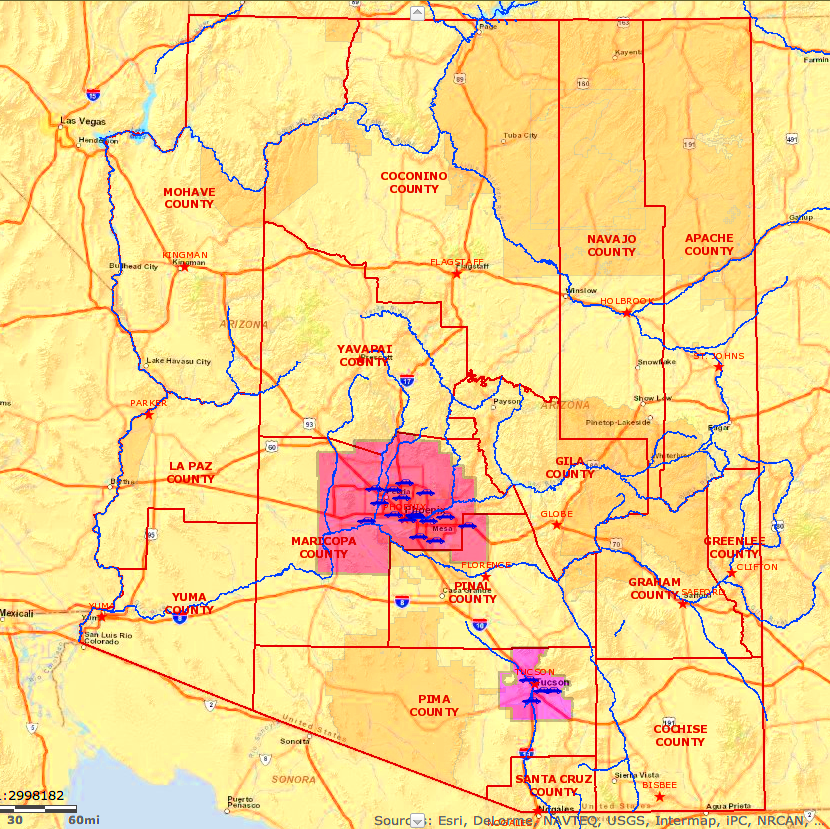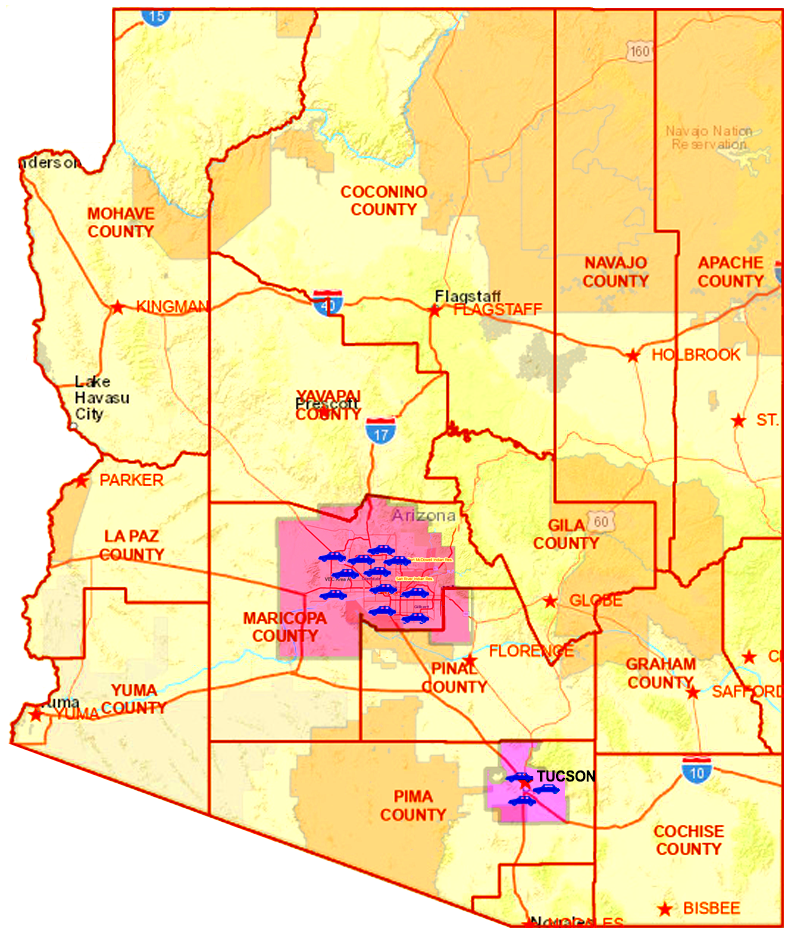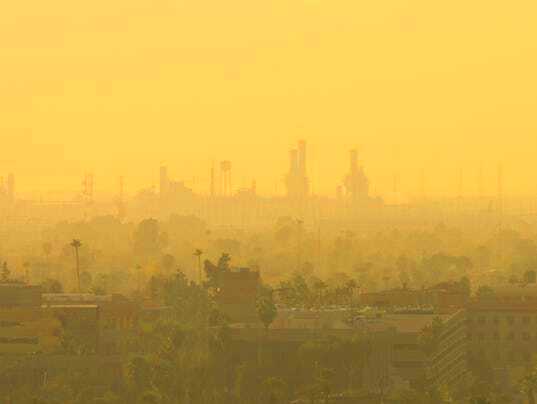Enforcement of Smog Standards in Arizona
Many metropolitan areas experience a serious problem with smog, and Arizona is not different. As the population increases, the need for unpolluted air rises too. Smog regulations are meant to improve the quality of air and safeguard public health. Consequently, they help in moderating several harmful emissions from cars and industries in order to lower pollutant levels and enhance residents’ living conditions. Therefore, it is imperative for all those who dwell in this state to know these regulations.
History of Smog Standards Implementation

The journey of enforcing smog standards in Arizona began in the 1970s when the federal government established the Clean Air Act. This act set the framework for states to create their air quality regulations. In Arizona, the Arizona Department of Environmental Quality (ADEQ) took charge of implementing these standards.
There have been numerous challenges encountered by Arizona throughout the years:
- Rapid Population Growth: As more people moved to the state, air pollution increased, prompting the need for stricter regulations.
- Vehicle Emissions: The rise in vehicle ownership contributed significantly to smog, leading to the introduction of emission testing programs.
- Industrial Emissions: Industries were identified as major contributors to air pollution, leading to regulatory changes and enforcement actions.
By the late 1990s, Arizona adopted the State Implementation Plan (SIP) to address these challenges. The SIP outlined strategies to achieve and maintain air quality standards, focusing on reducing emissions from various sources.
Current Smog Standards in Arizona

Currently, Arizona follows a series of strict anti-smog norms designed at controlling air pollutants. These rules comply with the federal guidelines and address the reduction of hazardous substances like ozone, particulate matter, as well as nitrogen oxides.
Current smog standards comprise fundamental parts including:
- Ozone Standards: Arizona aims to meet the National Ambient Air Quality Standards (NAAQS) for ozone, which set limits on ground-level ozone concentrations.
- Vehicle Emissions Testing: The state requires emissions testing for vehicles to ensure they meet specific emission limits before registration.
- Industrial Regulations: Industries must comply with regulations that limit their emissions of volatile organic compounds (VOCs) and other pollutants.
- Public Awareness Campaigns: The state runs educational campaigns to inform residents about the importance of reducing emissions and protecting air quality.
Such endeavors are essential for enhancing air quality as well as providing better surroundings to everyone living in Arizona.
Key Agencies Involved in Enforcement
One endeavor agreeing with smog standards in Arizona is a group effort which involves different organizations working together. All organizations are important for making sure air quality rules are obeyed and people’s well-being is safeguarded. Some of these key players include:
- Arizona Department of Environmental Quality (ADEQ): This is the primary agency responsible for enforcing air quality regulations. ADEQ develops and implements policies, conducts inspections, and oversees emissions testing.
- Environmental Protection Agency (EPA): As the federal authority, the EPA sets national air quality standards. They work alongside state agencies to ensure compliance and provide guidance on best practices.
- Arizona Department of Transportation (ADOT): ADOT plays a crucial role by managing vehicle emissions testing programs and promoting cleaner transportation options.
- Local Air Quality Control Districts: Many counties in Arizona have their air quality districts that enforce local regulations and respond to specific pollution issues.
The collaboration of various organizations focuses on overseeing the atmosphere, making observations and releasing programs aimed at minimizing harmful emissions. This composite act protects individuals and surroundings in Arizona of these three groups together.
Methods of Monitoring Air Quality
There are multiple ways to monitor pollution levels and check compliance with regulatory norms since monitoring air quality is necessary for proper smog regulation. The following is a list of unknown major approaches:
- Air Quality Monitoring Stations: Arizona has a network of monitoring stations strategically placed throughout the state. These stations measure pollutants like ozone, particulate matter, and nitrogen oxides in real-time.
- Satellite Observations: Satellites provide valuable data on air quality over large areas, helping identify pollution sources and track changes in air quality trends.
- Mobile Monitoring Units: These units are deployed in specific areas to gather data on air quality and pollution levels, especially during events like wildfires or dust storms.
- Community Monitoring Programs: In some areas, local communities participate in monitoring efforts, providing valuable data on air quality from a grassroots perspective.
When agencies use these approaches together with other measures, they will be able to monitor the air quality effectively, determine the sources of pollution and take all the required steps for maintaining and enhancing air standards.
Impact of Smog on Public Health and Environment
Severe effects on public health as well as environment can be caused by smog. It is important to understand these impacts to emphasize the need for enforcing smog standards. This is how smog affects us:
- Health Risks: Exposure to smog can lead to respiratory issues, heart problems, and other serious health conditions. Vulnerable groups, such as children and the elderly, are at higher risk.
- Environmental Damage: Smog can harm vegetation, leading to reduced crop yields and harming natural ecosystems. Acid rain, caused by air pollutants, can damage forests, lakes, and wildlife.
- Economic Costs: Health problems linked to air pollution can result in increased healthcare costs and lost productivity. Poor air quality can also deter tourism and affect local economies.
- Climate Change: Some pollutants contribute to climate change, leading to long-term environmental challenges that affect all living beings.
Strengthening stricter smog standards and enforcing laws is essential to acknowledge these impacts. When we put more emphasis on air quality, we can be sure of protecting our lives, conserving nature and building an even brighter tomorrow for humanity at large.
Challenges in Enforcing Smog Standards
Enforcement of smog standards in Arizona faces even more difficulties. All these issues can stand in the way of efficient enforcement despite being best practices for agencies and organizations. Following are some major challenges:
- Rapid Urbanization: As cities grow, the increase in vehicle traffic and industrial activities leads to higher emissions. Managing air quality in rapidly urbanizing areas can be particularly difficult.
- Public Awareness: Many residents may not be aware of smog’s health effects or the importance of following regulations. This lack of awareness can lead to non-compliance and increased pollution levels.
- Funding Constraints: Budget limitations can restrict monitoring efforts, enforcement actions, and public education campaigns. Agencies may struggle to secure the necessary resources to effectively combat air pollution.
- Climate Variability: Natural events, like wildfires and dust storms, can significantly impact air quality. These unpredictable occurrences complicate efforts to maintain consistent air quality standards.
- Resistance from Industries: Some industries may resist changes to regulations or funding for pollution control measures, arguing that stricter standards could impact their operations and profitability.
Having an increased public awareness together with inter-agency collaboration and sustainability commitment will help address these challenges. It is only through cooperation that proper smog standard enforcement in Arizona can achieve meaningful progress.
Future Directions for Smog Control in Arizona
In the future to come, the control of smog in Arizona is likely to take interesting dimensions. By adopting new techniques and technologies, this state can even have better air quality management. Below are some possible future directions:
- Advanced Monitoring Technologies: Investing in cutting-edge air quality monitoring systems can provide real-time data and improve response times to pollution spikes.
- Stricter Emission Standards: Implementing tighter emissions regulations for vehicles and industries can help lower overall pollution levels and improve air quality.
- Incentives for Clean Energy: Promoting renewable energy sources and offering incentives for electric vehicles can reduce reliance on fossil fuels, thereby decreasing emissions.
- Public Education Campaigns: Raising awareness about the health effects of smog and promoting environmentally friendly practices can empower residents to take action and reduce pollution.
- Collaboration with Local Governments: Partnering with local municipalities to implement air quality initiatives can lead to more targeted and effective enforcement strategies.
In thus what direction, Arizona should take to ensure its inhabitants have cleaner and healthier surroundings as well as lay foundation for sustainability.
FAQs About Smog Standards Enforcement
In Arizona, smog standards enforcement is subjected to several commonly asked questions.
- What are smog standards? Smog standards are regulations set to limit air pollution levels, ensuring that air quality remains safe for public health and the environment.
- Who enforces smog standards in Arizona? The Arizona Department of Environmental Quality (ADEQ), along with other agencies like the EPA and local air quality control districts, is responsible for enforcement.
- How is air quality monitored? Air quality is monitored through a network of monitoring stations, satellite observations, and community programs that track pollution levels and trends.
- What can individuals do to help improve air quality? Individuals can reduce their carbon footprint by using public transportation, carpooling, and minimizing the use of fossil fuels. Supporting clean energy initiatives also helps.
- What are the health effects of smog? Smog can cause respiratory issues, heart problems, and other serious health conditions, particularly in vulnerable populations like children and the elderly.
Comprehending such facets of smog regulations enforcement can enable some to take part in making the atmosphere more breathable and livable.
Conclusion on the Importance of Smog Standards
In Arizona, smog standards are indispensable in preserving air quality and safeguarding public health. They significantly contribute to reducing pollution levels across the board and fostering a healthier environment for everybody by placing limits on hazardous emissions released into the atmosphere from vehicles as well as from industries. For public health reasons, even when faced with obstacles, these regulations need to be enforced consistently since they will keep down air pollution-related risks. To better serve their function, smog control policies should focus on ingenious tactics, educate the public about them and stimulate cooperation among different organizations; this is what an ever-evolving state requires. Clean air becomes available for everyone because of stringent smog standards that promote sustainable development in the long run.


